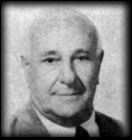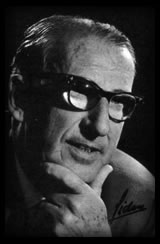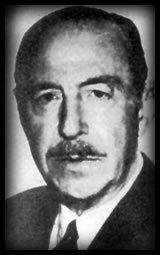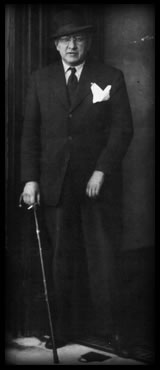By
The "Troupe Ateniense" (The Athens Group), subject of an interesting radio talk

ack in 1922 the Club Atenas was drifting like gypsies used to do», Víctor Soliño tells us in his book Mis tangos y los atenienses (1967). It had been founded 4 years before making its debut at the Sporting Plaza Nº 3 of the Parque Rodó. The Café Welcome was its provisional head office. It was located on the 18 de Julio Avenue between Río Branco and Julio Herrera y Obes. Its owner was Benito Romay, a bohemian who preferred quality rather than quantity as far as customers were concerned. It consequently derived, time later, in the sale of the business.
 The origin of the Troupe was a contest organized by the Students Center in the Law School to stage a play for the celebration of the coming spring season. The board was made up by doctors Emilio Frugoni, Dardo Regules and Carlos María Prando. A group of friends presented the play ¿Estás ahí, Montevideo? for consideration of the board. They used a phrase in vogue at that time in the city where everybody in the streets was asking: «¿Estás ahí?» (Are you there?). The plot of the play was based on the fact that the protagonist, a student of the University of Salamanca, Don Félix de Montemar, bored and nostalgic in hell, was asking Satan to allow him to «go down» to Montevideo for reviving the memories of the Salamanca classrooms together with the students of those days.
The origin of the Troupe was a contest organized by the Students Center in the Law School to stage a play for the celebration of the coming spring season. The board was made up by doctors Emilio Frugoni, Dardo Regules and Carlos María Prando. A group of friends presented the play ¿Estás ahí, Montevideo? for consideration of the board. They used a phrase in vogue at that time in the city where everybody in the streets was asking: «¿Estás ahí?» (Are you there?). The plot of the play was based on the fact that the protagonist, a student of the University of Salamanca, Don Félix de Montemar, bored and nostalgic in hell, was asking Satan to allow him to «go down» to Montevideo for reviving the memories of the Salamanca classrooms together with the students of those days.
On September 26, 1922 the then Troupe Jurídica (Legal Group) made its debut. When the curtain fell the enthusiastic audience was unwilling to leave the theater. The press joyously welcomed the debut of the group that, later, would become a legend: La Troupe Ateniense. It is worth mentioning that one of the most enthusiastic theater critics was doctor Víctor Pérez Petit of La Defensa newspaper.
In the early 1923, after some misunderstandings, the Troupe split with the Students Center and adopted its definitive name. Some friends with the best of intentions reduced the gaps between the parties in dispute and they reached an agreement: it would be then the Troupe Jurídico Ateniense. The first magazine —after the agreement—, was entitled Tut Ankh Amon and consisted of the tales of a Pharaoh in these lands. It was a boom. For example the scenery of the Plaza Independencia with the statue of Artigas by the sculptor Ramón Bauzá was craftily made of papier-mache. The most important work of this sculptor is the monument to the poet Bartolomé Hidalgo located at the Pasaje Hermanos Ruiz at the corner of Agraciada Avenue. In this picture a dialogue between hero and horse was staged while all the figures in the political, show business and social fields that that year were in the Montevideo news were parading and were warmly praised.
 The debut was on September 21, 1923 at the Teatro Urquiza. That theater was located on Mercedes and Andes, and later was bought to be the Estudio Auditorio del SODRE, now disappeared. The tickets were sold out at $ 2 for stalls and 30 cents for admission to the upper gallery.
The debut was on September 21, 1923 at the Teatro Urquiza. That theater was located on Mercedes and Andes, and later was bought to be the Estudio Auditorio del SODRE, now disappeared. The tickets were sold out at $ 2 for stalls and 30 cents for admission to the upper gallery.
Ramón Collazo had an special idea. He changed the tragic ending of the parodied play (a train which spectacularly derailed due to a sabotage made by underworld guys) to a general laughter by the audience, because at the time of its culmination, at the crucial minute of suspense, a cheeky Italian peanut vendor with his ridicule locomotive appeared onstage.
The voyage to Buenos Aires
The young «troupenses» began to dream of appearing in Buenos Aires. Don Vicente Curci, linked to the theater business, risked a lot of money on the venture the Troupe was longing for. Their debut was on October 11, 1923 at the Teatro Coliseo and they were so successful that the theater impresario had to place a notice in the box office: «Tickets sold out». With the vermouth section (from 5pm to 7 pm) on Sunday 14 it was thought that the mini- season would end due to engagements which could not be postponed by some members of the group who had to be in Montevideo on Monday. Because of the overwhelming boom, the wife of the Uruguayan Ambassador to Buenos Aires achieved something almost impossible: she succeeded in postponing the departure of the Vapor de la Carrera until 1 in the morning so that another performance would be added.
That afternoon the Gran Premio Nacional was to be run and the oriental horse stables were represented by Sisley, a horse ridden by Benjamín Gómez. Some, because they were horse racing addicts, and others, putting the blame on a gambling patriotism, took the money that still was left after long nights of bust and bet it on the legs of the Uruguayan crack.
 The playwright trio that staged the first hit of the Troupe was made of César L. Gallardo, Roberto Fontaina and Víctor Soliño. Due to demands of his legal profession Gallardo quit later but his peers would continue until the closing day in 1930.
The playwright trio that staged the first hit of the Troupe was made of César L. Gallardo, Roberto Fontaina and Víctor Soliño. Due to demands of his legal profession Gallardo quit later but his peers would continue until the closing day in 1930.
During the world frenzy for anything that seemed to be jazz the Troupe staged a vaudeville scene with a mimicry of the Harlem dancers. It was a boom.
When either Christian Dior or other fashion names were not yet known worldwide, Valiante was the best known fashion designer in Montevideo. He used to say that nobody was able to parade better his spring and summer collections than the brawny ladies of the Troupe. The high society dames and young ladies understood it and went to the performances to watch in detail the designs for the following season.
For the scene The athletes —that belonged to the revue The Three Musketeers— that featured Casaña, David Estévez Martín, Sapelli, Juan Antonio Collazo and Corgo – the clothing was not too suitable, certainly.
 So as to make envious Scotland Yard itself, the Troupe members had their own Investigation Division. Among them we have Gerardo Matos Rodríguez, center, with big moustaches and black overcoat. The first at the left, Alfredo Basso (Ojo ‘e trapo, Eye O’ Rag); the third, the great athlete David Estévez Martín; the one before last, Marco Aurelio Bianchi, the popular humorist Colelo, an excellent crooner and, furthermore, and inspired composer.
So as to make envious Scotland Yard itself, the Troupe members had their own Investigation Division. Among them we have Gerardo Matos Rodríguez, center, with big moustaches and black overcoat. The first at the left, Alfredo Basso (Ojo ‘e trapo, Eye O’ Rag); the third, the great athlete David Estévez Martín; the one before last, Marco Aurelio Bianchi, the popular humorist Colelo, an excellent crooner and, furthermore, and inspired composer.
Precisely at the time when the scene entitled Plaza Independencia —in which the Artigas statue appeared— was taking place the news were known in the theater. And the hero, who was impersonated by Roberto Fontaina (who had risked some tickets on the race) jumped on the horseback and shouted out loud: «Sisley, you're the one and only!». The audience immediately understood and an enthusiastic clap of hands broke out. The extra performance of the night, because of the little time available, had nearly none due advertising. Hardly they succeeded in publishing the news in the later editions of Crítica and Última Hora. But in that series of miracles they were living no one was surprised by one miracle more. An hour after the newspapers were published there was no theater ticket available.
The finale that took place among the stalls —the players now with their luggage ready— had an unexpected feature: half of the cast—those who had had time to get rid of the make-up and dress— were parading in plain clothes and the ones that were starred in the final scene wore the clothes and wigs used in the revue. The Argentine families that witnessed the performance offered the available seats of their cars to drive the artists to the dock and other ones lent their cars with their corresponding drivers at the complete disposal of the Troupe members.
Half of the people present at the theater went to the harbor to express to them, once more, all the affection that this brilliant delegation had arisen. A few minutes before the anchors were aweigh and after having sung the anthems of the traveling group and the one of their fans, Carlos Quijano, who presided the delegation, onboard started with an oratory efficiency a speech thanking in heartfelt words that unusual display of affection. Hundred of hoarse throats expressed to Quijano their recognition for so brilliant words. A few members of the Troupe stayed some days in Buenos Aires to thank the many attentions given.
The day after the departure, on the dock where customarily the Vapor de la Carrera was anchored, two big boxes with horses inside were waiting that a tow truck would place them on the steamboat deck. One was Sisley, the Uruguayan crack that was coming back to his fatherland to reprise the great deed of winning again the Gran Premio Nacional in Maroñas on the following Sunday and, the other was the Troupe’s worn-out papier-mache horse. By chance a photographer of the Crítica newspaper was there and he did not feel like missing the note. The next day in the Buenos Aires daily paper a big photo was published with the following words: «Two great Uruguayan horses that were winners in Buenos Aires».
Sisley was the first Uruguayan horse that won the Gran Premio Nacional on both banks of the River Plate. The effects of its victory were soon known: A few days later the Max Glücksmann company announced a motion picture that alluded to the triumph of the Uruguayan crack.
Quoted from the talk aired in the program Deportísimo siglo XXI, on CX42 Emisora Ciudad de Montevideo.
Editor’s note:
 Among the figures of La Troupe, we have to single out the singer Alberto Vila, also a good mimic. The latter, because of his success in the neighboring river bank, was hired by the Victor company in 1927 and recorded a great number of discs.
Among the figures of La Troupe, we have to single out the singer Alberto Vila, also a good mimic. The latter, because of his success in the neighboring river bank, was hired by the Victor company in 1927 and recorded a great number of discs.
In 1924, La Troupe Ateniense returned to Buenos Aires with the play Oh, les sauvages, a homage to the Olympic triumph of the Uruguayan soccer team in France. It was staged at the Teatro San Martín to great acclaim. It was a box office boom.
The Troupe ended its appearances in 1930 with Centenariola celebrating the brand-new triumph of the soccer team against Argentina at the World Soccer Championship that took place in Montevideo that year. It was premiered on August 14 at the Teatro Solís and its last performance was on August 27. It was the end of the story and, paraphrasing Cátulo: «Corriéndole un telón al corazón» (drawing the curtain to our heart).